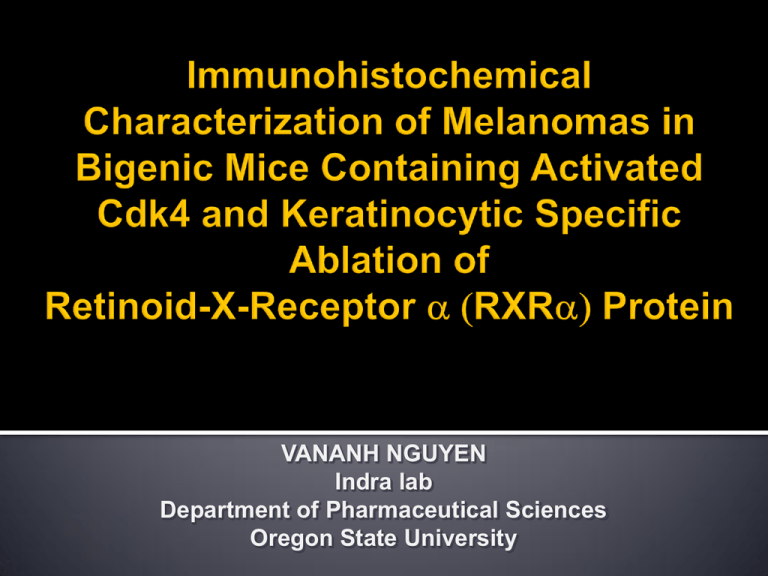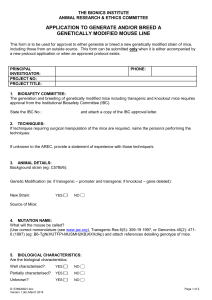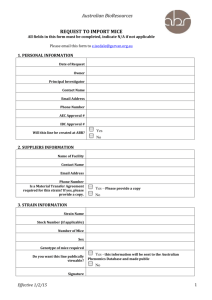VANANH NGUYEN Indra lab Department of Pharmaceutical Sciences
advertisement

VANANH NGUYEN Indra lab Department of Pharmaceutical Sciences Oregon State University The deadliest form of skin cancer The 5th most common invasive cancer in Oregon Rank 7th in nation in incident rates Mortality rate 26% higher than national rate No effective treatment for metastatic melanoma Anatomy of skin Largest organ in the body 3 main layers: Epidermis Dermis Subcutis (hypothermis) http://training.seer.cancer.gov/melanoma/anatomy/ Cornified layer Granular layer Spinous layer (Squamous cell layer) Basal layer http://www.pg.com/science/skincare/Skin_tws_16.html Melanocytes to keratinocytes Melanocyte manafactures tiny melanin granules One melanocyte produces 36 keratinocytes with melanin granules http://training.seer.cancer.gov/melanoma/anato my/layers.html Active vitamin A derivative Regulate growth and differentiation of cells Nuclear receptors binding Perissi, Nat Rev Mol Cell Biol, 2005 Retinoic acid receptor (a,b,g) (DR1, DR2, DR5) PPAR (a,b,g) Vitamin D (DR1) receptor (DR3) TRs (α,β) RXRs RXRs (DR4) (a,b,g) (DR1) Liver X receptor (a,b) (DR1) Farnesoid X receptor NGFI-B/NURR1 (orphans) Pregnane X receptor Cyclin-dependent kinase family (CDKs) Proteins kinases require cyclin to function Involved in cell cycle control Target for anticancer medication http://php.med.unsw.edu.au/cellbiology/index.p hp?title=2009_Lecture_15 Cyclin-dependent kinase 4 (CDK4) CDK’s inhibitor p16Ink4a is a tumor suppressor protein CDK4 is a product of Ink4a locus Involved in G1 phase Point mutation of arginine (R) to cystine (C) (Cdk4R24C/R24C) inhibits p16 HYPERACTIVITY in cell cycle Hypothesis 1. Increased melanocytes proliferation due to ablation of RXRα could be due to deregulated cell cycle control CDK4 2. Loss of RXRα in combination of activated CKD4 increases metastatic progression Methodology Transgenic mice preparation Genotyping Two-step chemical tumorgenesis Collecting tissue samples Histological and immunofluorescence analyses Site-specific ablation of RXRα Cre-lox systems to knock-out RXRα in epidermal keratinocytes Cre Human K14 Promoter K14-Cre loxP RXRaL2 E3 loxP E4 GENOTYPE CONTROL : K14-Cre (-/-)/RXRaL2/L2 MUTANTS : K14-Cre (tg/-)/RXRaL2/L2 NEO E5 3’ EPIDERMIS RXRaL2/L2 RXRaL-/L- (RXRaep-/-) Methodology Transgenic mice preparation Genotyping Two-step chemical tumorgenesis Collecting tissue samples Histological and immunofluorescence analyses Genotyping DNA isolation: ▪ Tail samples of 10-day old mice ▪ Incubated in Dispase overnight ▪ Digested using proteinase K in solution ▪ Heated in water bath Amplified with semi-quantitative Polymerase Chain Reaction (PCR) Gel electrophorisis Desired genotype groups Control group: RXRaL2/L2 Single mutated groups: (additional controls) RXRaep-/ Cdk4R24C/R24C (Knock-in mutation) Bigenic mice: RXRaep-/- /Cdk4R24C/R24C Methodology Transgenic mice preparation Genotyping Two-step chemical tumorgenesis Collecting tissue samples Histological and immunofluorescence analyses Chemical tumorigenesis Initiation, Promotion and Progression model ▪ DMBA (7,12-dimethyl-benz[a]anthracene) – tumor initiator – 50μg/100μg acetone single application ▪ TPA (phorbol ester 12-O-tetradecanoylphorbol-13 acetate) – tumor promoter – 5μg/100μg acetone 2 times/week for 25 weeks Weeks of treatment Methodology Transgenic mice preparation Genotyping Two-step chemical tumorgenesis Collecting tissue samples Histological and immunofluorescence analyses Tissue samples Collect tissue samples and melanocytic tumors Fix tissues in 4% paraformaldehyde Dehydration process with EtOH Embed in paraffin Cut into 5μm thick using Microtome Methodology Transgenic mice preparation Genotyping Two-step chemical tumorgenesis Collecting tissue samples Histological and immunofluorescence analyses Histological analyses Hematoxylin and Eosin staining (H&E) To visualize epidermal thickening and melanocytic growths Immunohistochemistry (IHC) Depariffinized, rehydration and antigen retrieval Melanocytic proliferation: Melanocytic specific marker TRP1 (green) Proliferation marker PCNA (red) Counterstained DAPI (blue) Maglinant nature of tumors: Cocktail directed against melanoma antigens MART-1 and HMB45 Vasculization: CD31 antibody Increase in tumors size in RXRaep-/- and RXRaep-/- /Cdk4R24C/R24C * = p < 0.05, ** = p < 0.01, *** = p < 0.001. Results *p < 0.05 ** = p < 0.01 *** = p < 0.001 Results Significantly higher percent of co-labeling in bigenic mice than Cdk4R24C/R24C 67% vs. 21% P-value < 0.01 Results Higher staining for maglinant melanocytes in bigenic mice than Cdk4R24C/R24C Increase vascularization in melanocytic tumors in bigenic mice than Cdk4R24C/R24C Increased melanocytes proliferation due to ablation of RXRα is due to deregulated cell cycle control CDK4 1. Higher melanocytes proliferation in bigenic mice than individual mutated group Loss of RXRα in combination of activated CKD4 increases metastatic progression 2. Higher maglinant potential in bigenic mice compared to individual mutated group Acknowledgement Dr. Arup Indra Dr. Gitali Indra Stephen Hyter This work was funded by: OHSU MRF grant OSU College of Pharmacy start-up fund NIH [NIAMS] grant Zhizing Wang Xiaobo Liang Daniel Coleman Question?







